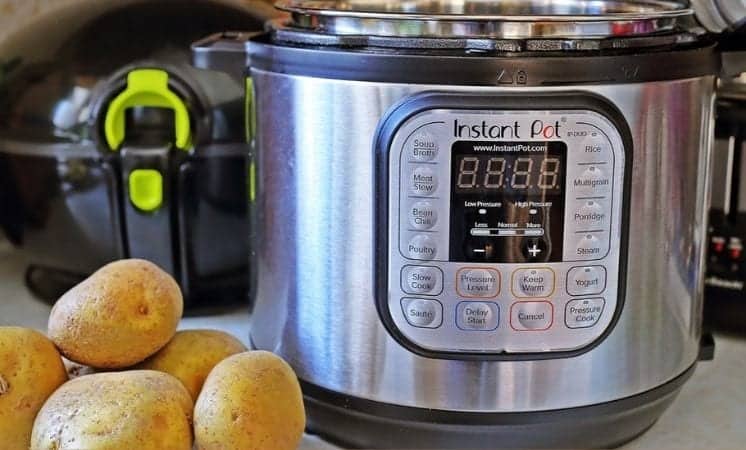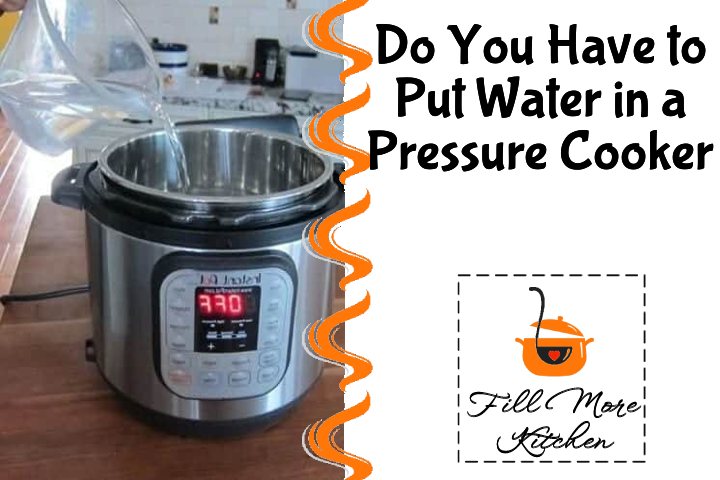While pressure cookers are known for their time-saving abilities and appear simple to use, individuals who are unfamiliar with how these appliances work may not realize the significance of water in ensuring their proper functioning.
To ensure that a pressure cooker can cook food rapidly, it needs to confine the steam generated from boiling liquid, which leads to an immediate increase in the internal pressure of the cooker; therefore, if there is no boiling water, there will be no steam and consequently no rise in pressure inside the cooker.
Is it necessary to add liquid to a pressure cooker? Yes, it is essential to add water or other liquids like broth or wine before using the pressure cooker to prepare a tasty meal. Without any liquid, the pressure cooker will not be able to generate pressure and will not function as intended.
How Much Water Does a Pressure Cooker Need?
Whether or not you need to add water to your pressure cooker depends on the recipe, the size of your cooker, and the ingredients you are using. To determine the exact amount of liquid required, it is recommended to refer to the instruction manual that came with your pressure cooker.
One brand of pressure cooker, the Instant Pot, has a minimum water requirement of 1 1/2 cups or 375ml, whereas another brand, the Fagor LUX, only needs 1/2 cup or 125 ml due to its use of a spring valve instead of float valves like the Instant Pot.
- If you have a pressure cooker with a “jiggle top,” it is recommended to use at least one cup of water, which will suffice for twenty minutes of cooking.
- When using a pressure cooker with a valve, it is typically necessary to have at least 1/2 cup of liquid.
If you are uncertain about the required amount of water for your pressure cooker, opt to fill it with water below the midpoint.
Can You Put Too Much Water in a Pressure Cooker?
It is necessary to have water in a pressure cooker for it to function, but overfilling the vessel with water is possible. It’s crucial to keep in mind that the pressure cooker operates in a sealed environment, resulting in considerably less evaporation than an open pot on a stove.
Excessive addition of liquid in a pressure cooker can result in various unfavorable outcomes such as a tasteless dish, runny sauce, or an overfilled cooker due to food expansion.
If you are unsure about the amount of liquid to use in your pressure cooker, it is recommended to use 1/2 to 1 cup of liquid unless the instruction manual or recipe specifies a different minimum. To ensure that the pressure cooker reaches maximum pressure, add enough water while keeping it below the halfway mark.
Can You Overfill a Pressure Cooker with Food & Water?

It is important to note that regardless of the size of your pressure cooker, it should never be filled completely with food and water as this goes against its intended use.
Overfilling your pressure cooker with ingredients can result in uneven cooking, prevent the cooker from reaching maximum pressure, or cause it to take an extended period to pressurize. These are the potential hazards of putting too much food in a pressure cooker.
- If there is an excessive amount of pressure inside the pressure cooker, it can result in the disintegration of your food and a lack of flavor.
- There is a possibility of food obstructing the pressure valve, which can lead to exceeding the maximum desired pressure levels.
- Putting too much water in your pressure cooker can result in irreversible harm to its components, such as any silicone seals it may have.
- Using the manual release method when the pressure cooker is overfilled can result in hot liquid spilling everywhere, which could cause severe second and third-degree burns.
If you want to determine the maximum capacity of your pressure cooker, refer to the instruction manual and locate the high and low maximum capacity options.
If you are cooking rice and grains in a pressure cooker, it is advisable to fill only half of the cooker as these foods tend to expand. The expansion of food can result in the production of foam, which can be dangerous if not handled carefully while removing the lid of the pressure cooker.
Can You Put Oil and Other Liquids in a Pressure Cooker?
If you want to add a flavoring liquid or cooking sauce to your pressure cooker, you can use thin liquids such as wines, broths, vegetable stocks, and beer without any restriction on the maximum liquid volume required for the pressure cooker to function properly.
Nevertheless, in case you intend to include dense sauces, it is necessary to dilute them by pouring a minimum of 1/4 cup of water for every 2 cups of sauce; otherwise, the sauce will merely stick to the bottom.
When using a pressure cooker, it is advisable to avoid adding dairy products such as cream cheese, yoghurt, or milk since the high heat can cause them to separate and curdle; therefore, it is better to incorporate them into the dish after completing the cooking phase.
If you are using thickeners such as cornstarch or cooking with a dense soup or stew, it is advisable to add them after the food has been cooked since adding them during the cooking process can have an adverse effect on how the food cooks due to reduced steam release from thicker liquids.
Can I Use Oil In My Pressure Cooker?
It is strongly advised not to use oil in a pressure cooker as it is not designed for frying and can lead to hazardous situations.
As the boiling point of oils is higher than that of water, the vapor of oil will be reduced in a pressure cooker since it operates by elevating its pressure through liquid.
Not adding water to your pressure cooker can result in cooking the oil at high temperatures, which can dissolve the sealing ring, overcook the food, or put you in a hazardous situation while opening the lid.
It is important to remember that pressure cookers are not suitable for frying food as they are not designed to function as pressure fryers due to the high temperature required to generate boiling oil, which cannot be achieved by most standard pressure cookers.
Am I Stuck With Just Boiling My Food?
Definitely not! You can make the most of your pressure cooker by steaming or sauteing your food, but it’s crucial to clean it after every cooking method.
For enhanced taste and tenderness, consider searing vegetables and meats before incorporating them into your pressure cooker to achieve the Maillard effect.
You can also check this video about “Do You Have to Put Water in a Pressure Cooker?”
Check out our top 10 reviews!
Related posts
https://fillmorekitchen.com/can-you-make-popcorn-in-a-toaster-oven/
https://fillmorekitchen.com/can-an-oven-overheat-yes-so-heres-what-to-do/
https://fillmorekitchen.com/are-microwave-meals-pre-cooked/
https://fillmorekitchen.com/can-you-cook-sous-vide-without-plastic-bags/
https://fillmorekitchen.com/can-you-reheat-food-twice/



